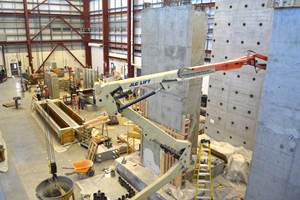Editorial - 7/1/2005
Well, it doesn't seem possible, but another summer is upon us. At least we've had a chance to unpack the suitcases after the spring trade show season. Yes, that's me (in the back, center) among a number of recognizable faces in this party photo taken while we were in Long Beach for the U.S. SAMPE show. Several of us
Well, it doesn't seem possible, but another summer is upon us. At least we've had a chance to unpack the suitcases after the spring trade show season. Yes, that's me (in the back, center) among a number of recognizable faces in this party photo taken while we were in Long Beach for the U.S. SAMPE show. Several of us are wearing ceremonial headwear presented by members of SAMPE's Japan Chapter.
Our staff saw quite an array of new technologies in Long Beach and, earlier this year, at the SAMPE Europe/JEC event in Paris. Obviously, the aerospace industry is healthy, particularly as rivals Airbus and Boeing fuel a lot of composites work with the A380 and 787 in Europe, the U.S. and the Pacific Rim. Another notable sign of health is the abundance of ongoing R&D, evidenced by the more than 370 papers presented at the two shows. The big surprise is the fast-growing field of nanomaterials, where commercial products are shaping up in applications such as shape-changing aircraft that were the stuff of science fiction only a few years ago. As an example, Cornerstone Research Group showed its shape-memory polymers in Long Beach, for possible future aircraft as well as immediate applications like flexible tooling that can be used over and over again, for different shaped parts. And by the way, HPC again was a sponsor of the Student Bridge Building Contest, in the carbon fiber "kit" category, in which the top honors were taken by a team from the University of Washington. It was gratifying to see the high level of student interest and participation and the hard work that SAMPE member Howard Kliger does to make the contest happen.
Our in-depth examination of space system design and manufacture is packed with detail on the ways composites manufacturers neutralize CTE in space-bound scientific instruments and communications reflectors. On p. 44, we have an exclusive report on a piezoelectric ceramic material now available in a fatigue-resistant flexible fiber form that permits its incorporation into composites. Piezoelectrics, when compressed, bent or flexed, can generate their own electrical charge, which can be stored and used to power "smart" sensors and other electrical devices. We also have an informative design story about Porsche's use of carbon fiber in its Carrera GT sports car, not only in exterior body components but in its chassis as well — a pioneering effort for a production automobile.
Speaking of carbon fiber, I'm sure that many of you are aware that Acordis, the U.K.-based producer of precursor for PAN-based carbon fiber, is for sale and has been put on "administrative status" (the British equivalent of U.S. Chapter 11 bankruptcy). If the plant doesn't sell and production ceases, that could cut off the fiber supply for makers of aerospace brakes who depend on the qualified Acordis precursor. Several industry observers have told me that Zoltek Corp. is moving to get its PAN precursor qualified for brake manufacturing, and I suspect other precursor manufacturers are considering the same strategy. At this point, it's unclear how the global carbon supply will be affected if Acordis production is lost. But our "Market Trends" columnist Henrik Olofsson has some definite opinions about how carbon supply might be made more consistent.
By the way, I'm in the midst of a trip, on foot, from my home in Denver, Colo. to my family home in Powell, Wyo., a distance of more than 500 miles. As I write this, I've walked as far as Laramie, Wyo. — the 144-mile mark. It's been much harder than I expected (isn't that true of all worthwhile endeavors?) and my feet aren't real happy right now, but it is a Great Adventure. I'll let you know if I make it.
I hope you're having a Great Adventure of your own this summer.
Related Content
Materials & Processes: Resin matrices for composites
The matrix binds the fiber reinforcement, gives the composite component its shape and determines its surface quality. A composite matrix may be a polymer, ceramic, metal or carbon. Here’s a guide to selection.
Read MoreKU researchers explore FRP materials for dams, levee reinforcement
To address aging infrastructure, a team of researchers at KU is conducting research into repairing and retrofitting 700-plus dams, levees and related structures nationwide using FRP materials.
Read MoreCleveland pedestrian drawbridge features FRP decking from Creative Composites Group
Lightweight molded panels with hybrid non-skid technology system make up the new double dutch-style bascule bridge completing Cleveland’s harbor loop.
Read MoreComposite rebar for future infrastructure
GFRP eliminates risk of corrosion and increases durability fourfold for reinforced concrete that meets future demands as traffic, urbanization and extreme weather increase.
Read MoreRead Next
CW’s 2024 Top Shops survey offers new approach to benchmarking
Respondents that complete the survey by April 30, 2024, have the chance to be recognized as an honoree.
Read MoreFrom the CW Archives: The tale of the thermoplastic cryotank
In 2006, guest columnist Bob Hartunian related the story of his efforts two decades prior, while at McDonnell Douglas, to develop a thermoplastic composite crytank for hydrogen storage. He learned a lot of lessons.
Read MoreComposites end markets: Energy (2024)
Composites are used widely in oil/gas, wind and other renewable energy applications. Despite market challenges, growth potential and innovation for composites continue.
Read More













.jpg;maxWidth=300;quality=90)








